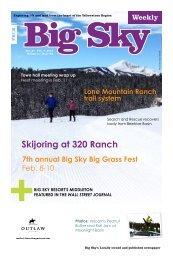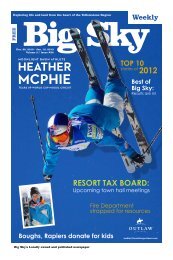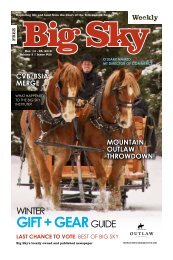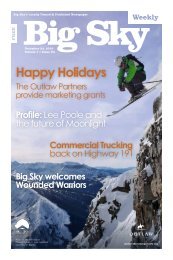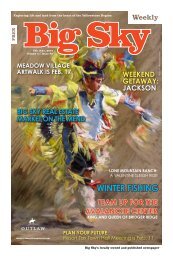HEALTH Strings Under the Big Sky - Explore Big Sky
HEALTH Strings Under the Big Sky - Explore Big Sky
HEALTH Strings Under the Big Sky - Explore Big Sky
Create successful ePaper yourself
Turn your PDF publications into a flip-book with our unique Google optimized e-Paper software.
wilderness mediCine<br />
explorebigsky.com<br />
Dehydration is a numbers game<br />
Facebook relationship: “it’s complicated”<br />
by dave mCevoy<br />
aerie backcountry medicine<br />
To understand dehydration, read<br />
about <strong>the</strong> financial turmoil in <strong>the</strong><br />
world. Being in massive debt hurts.<br />
It makes you irritable, weak and<br />
crampy. It gives you a headache and<br />
makes you susceptible to infections.<br />
Worst of all, it causes you to make<br />
bad decisions, jeopardizing yourself<br />
and those with you.<br />
Dehydration from sweat is a numbers<br />
game. Sweat is 99 percent water.<br />
This water comes directly from your<br />
blood, where you have roughly five<br />
liters in circulation. Yet only half of<br />
your blood is water, meaning you<br />
only have 2 – 3 liters of water to<br />
sweat.<br />
For obvious reasons, like death, having<br />
no water in your blood would be<br />
very bad. To avoid this, your body<br />
begins running a tab on water, borrowing<br />
it from <strong>the</strong> tissues, where<br />
you have over 30 liters in reserve.<br />
This is a normal part of a healthy<br />
body process. Rest, drink and eat,<br />
and your body replenishes <strong>the</strong> loss.<br />
Trouble comes when you ignore <strong>the</strong><br />
deficit and continue running <strong>the</strong> tab.<br />
If dehydration were in a relationship<br />
on Facebook, it would have<br />
<strong>the</strong> descriptor “it’s complicated.”<br />
Because we borrow water from all<br />
body tissues, dehydration can be felt<br />
in isolated muscles or lead to a bodywide<br />
crisis. You might feel like you<br />
have anything from a pulled muscle<br />
to <strong>the</strong> flu, and not know what part<br />
dehydration is playing in any of it.<br />
To keep it simple, focus more attention<br />
on avoiding water debt than on<br />
treating it.<br />
PreVenTion Do’S<br />
acclimatize<br />
It takes your body 6-10 days to acclimatize<br />
to a warm environment,<br />
after which time you sweat more efficiently,<br />
radiate heat more readily,<br />
and feel a lot better exercising in <strong>the</strong><br />
heat. To best acclimatize, you need<br />
to break a sweat every day for about<br />
an hour during this process.<br />
moderate activity<br />
Short, frequent breaks in <strong>the</strong> shade<br />
are essential to prolonged activities,<br />
particularly with high temperatures<br />
and humidity. Don’t mistake this as<br />
wimpy advice for pampered people.<br />
Everyone, from soldiers in combat to<br />
extreme athletes, needs to periodically<br />
reduce activity when working<br />
hard in a hot environment.<br />
drink enough to pee clear and<br />
often<br />
This usually means 2 – 6 liters of<br />
water over <strong>the</strong> course of each day of<br />
strenuous outdoor activity. That’s<br />
more than we’re accustomed to<br />
drinking but is critical to avoid going<br />
into water debt with your tissues. It<br />
is possible to drink too much water.<br />
This condition, called hyponatremia,<br />
typically happens during endurance<br />
events with participants pushing<br />
<strong>the</strong>mselves at high levels for many<br />
hours and significantly exceeding<br />
<strong>the</strong> above fluid recommendations.<br />
Wear proper clothing<br />
The key is wearing materials with<br />
little or no insulating value that allow<br />
airflow over <strong>the</strong> skin.<br />
Consider adding electrolytes to<br />
your water<br />
Endless debate surrounds <strong>the</strong> efficacy<br />
and need to supplement drinking<br />
water with electrolytes. While<br />
electrolyte solutions with less than<br />
8 percent carbohydrates can help<br />
prevent and treat some forms of heat<br />
illness (particularly when a well-balanced<br />
diet isn’t possible) <strong>the</strong>y aren’t<br />
a substitute for eating well and<br />
resting. By <strong>the</strong> way, recent evidence<br />
refutes an old <strong>the</strong>ory that electrolytes<br />
help prevent hyponatremia.<br />
PreVenTion Don’TS<br />
don’t rely on pounding water<br />
It doesn’t work. You won’t absorb<br />
most of it and instead will feel sick<br />
or vomit. Instead, drink about a halfliter<br />
per hour of activity, as well as a<br />
liter before and after activity.<br />
don’t rely on adding electrolytes<br />
to water<br />
Electrolytes are essential for basic<br />
function, and adding electrolytes<br />
to water can be very helpful, but<br />
we get most of what we need from<br />
food. Don’t believe <strong>the</strong> hype about<br />
expensive drinks at <strong>the</strong> expense of<br />
thinking about drinking water and<br />
eating well.<br />
don’t rely only on thirst to guide<br />
fluid consumption<br />
Thirst is triggered only when you’re<br />
significantly dehydrated, meaning<br />
by <strong>the</strong> time you feel crappy and<br />
thirsty, you’re already well behind<br />
and hours from recovery.<br />
don’t think your body will get<br />
accustomed to dehydration<br />
It won’t, and it will punish you for<br />
treating it that way.<br />
TreaTMenT Do’S<br />
stop activity and slowly hydrate<br />
If a dehydrated person is conscious but<br />
weak, tired, nauseated, has a headache<br />
and/or muscle cramps, stop <strong>the</strong> activity<br />
for at least a few hours, take off restrictive<br />
clothing, move him into <strong>the</strong> shade,<br />
lay him down, get some cool water onto<br />
him, and slowly hydrate him. Nausea<br />
will seriously limit <strong>the</strong> amount he can<br />
drink, which is usually about a quarter<br />
to a half-liter per hour. Adding electrolytes<br />
and massaging cramping muscles<br />
can be beneficial.<br />
Cool off aggressively and plan for<br />
immediate evacuation<br />
If a dehydrated person is hot, hallucinating,<br />
unresponsive and unable to walk,<br />
cool him as quickly as possible; <strong>the</strong> fastest<br />
means of cooling him often includes<br />
spraying with water and fanning air. He<br />
also needs an immediate trip to a hospital.<br />
Until proven o<strong>the</strong>rwise with tests in<br />
that hospital, this is heat stroke, which<br />
is a life-threatening emergency with a<br />
very high mortality rate. It can come on<br />
quickly, without much warning.<br />
explorebigsky.com<br />
<strong>Big</strong> <strong>Sky</strong> Weekly<br />
TreaTMenT Don’TS<br />
don’t think recovery will be fast<br />
Remember, it can take hours to<br />
fully replenish water and electrolyte<br />
losses.<br />
don’t underestimate how many<br />
ways dehydration can affect you<br />
Dehydration affects all body systems,<br />
making a person feel tired,<br />
crampy, nauseated and irritable.<br />
As such, it’s a contributing factor<br />
to many of <strong>the</strong> most common<br />
and serious backcountry illnesses<br />
and injuries. Preventing it is fairly<br />
simple. Treating it can be long and<br />
challenging. It’s an easy choice!<br />
David McEvoy is a paramedic and<br />
<strong>the</strong> director of Aerie, a wilderness<br />
medicine training organization based<br />
in Missoula. Aerie teaches Wilderness<br />
First Aid, Wilderness First<br />
Responder and Wilderness EMT<br />
courses at MSU in Bozeman.<br />
aeriemedicine.com<br />
Have a pain-free<br />
summer<br />
Try Osteopathic Manipulation<br />
For Back Pain, Headaches, Joint Injuries,<br />
Digestion Problems & More<br />
Pediatrics • Chronic Conditions • Women’s Health<br />
Pregnancy Care • Osteopathic Manipulation<br />
Maren Dunn D.O.<br />
Board Certified in Family Medicine<br />
18 Meadow Village Drive, <strong>Big</strong> <strong>Sky</strong>, MT (across from <strong>the</strong> post office)<br />
Phone: 406-995-3111 | gallatinfamilymedicine.com<br />
Open 9 a.m.-5 p.m. weekdays<br />
June 29, 2012 55




